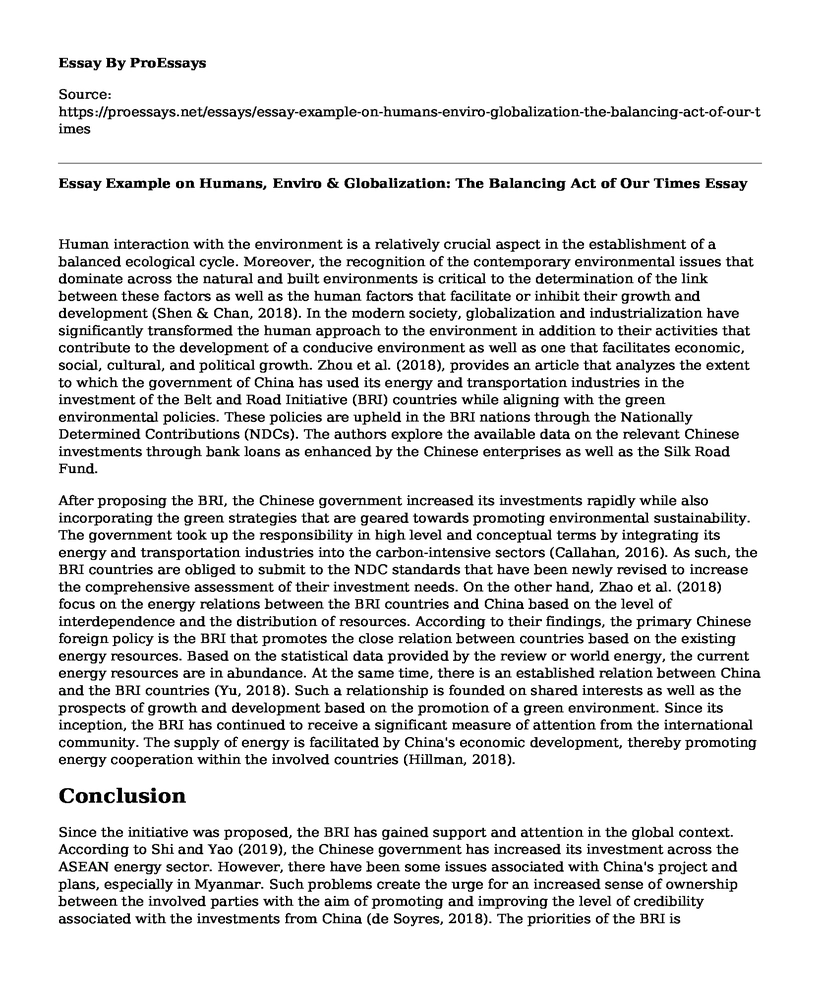Human interaction with the environment is a relatively crucial aspect in the establishment of a balanced ecological cycle. Moreover, the recognition of the contemporary environmental issues that dominate across the natural and built environments is critical to the determination of the link between these factors as well as the human factors that facilitate or inhibit their growth and development (Shen & Chan, 2018). In the modern society, globalization and industrialization have significantly transformed the human approach to the environment in addition to their activities that contribute to the development of a conducive environment as well as one that facilitates economic, social, cultural, and political growth. Zhou et al. (2018), provides an article that analyzes the extent to which the government of China has used its energy and transportation industries in the investment of the Belt and Road Initiative (BRI) countries while aligning with the green environmental policies. These policies are upheld in the BRI nations through the Nationally Determined Contributions (NDCs). The authors explore the available data on the relevant Chinese investments through bank loans as enhanced by the Chinese enterprises as well as the Silk Road Fund.
After proposing the BRI, the Chinese government increased its investments rapidly while also incorporating the green strategies that are geared towards promoting environmental sustainability. The government took up the responsibility in high level and conceptual terms by integrating its energy and transportation industries into the carbon-intensive sectors (Callahan, 2016). As such, the BRI countries are obliged to submit to the NDC standards that have been newly revised to increase the comprehensive assessment of their investment needs. On the other hand, Zhao et al. (2018) focus on the energy relations between the BRI countries and China based on the level of interdependence and the distribution of resources. According to their findings, the primary Chinese foreign policy is the BRI that promotes the close relation between countries based on the existing energy resources. Based on the statistical data provided by the review or world energy, the current energy resources are in abundance. At the same time, there is an established relation between China and the BRI countries (Yu, 2018). Such a relationship is founded on shared interests as well as the prospects of growth and development based on the promotion of a green environment. Since its inception, the BRI has continued to receive a significant measure of attention from the international community. The supply of energy is facilitated by China's economic development, thereby promoting energy cooperation within the involved countries (Hillman, 2018).
Conclusion
Since the initiative was proposed, the BRI has gained support and attention in the global context. According to Shi and Yao (2019), the Chinese government has increased its investment across the ASEAN energy sector. However, there have been some issues associated with China's project and plans, especially in Myanmar. Such problems create the urge for an increased sense of ownership between the involved parties with the aim of promoting and improving the level of credibility associated with the investments from China (de Soyres, 2018). The priorities of the BRI is characterized by the opportunity to increase the sense of ownership especially across the aspect of community networking that is the primary factor expected to facilitate the increased efficiency and effectiveness of the project. Precisely, the opportunity is structured around the provision of a good image as well as establishing successful investment projects.
References
Callahan, W. A. (2016). China's belt and road initiative and the new eurasian order. Norwegian Institute of International Affairs, 22.
de Soyres, F. (2018). The Growth and Welfare Effects of the Belt and Road Initiative on East Asia Pacific Countries. World Bank Group, (4).
Hillman, J. (2018). China's Belt and Road Initiative: Five Years Later. Diakses dari https://www. csis. org/analysis/chinas-belt-and-road-initiative-five-years-later-0.
Shen, S., & Chan, W. (2018). A comparative study of the Belt and Road Initiative and the Marshall plan. Palgrave Communications, 4(1), 1-11.
Shi, X., & Yao, L. (2019). Prospect of China's energy investment in Southeast Asia under the belt and road initiative: A sense of ownership perspective. Energy Strategy Reviews, 25, 56-64.
Yu, J. (2018). The belt and road initiative: domestic interests, bureaucratic politics and the EU-China relations. Asia Europe Journal, 16(3), 223-236.
Zhao, Y., Liu, X., Wang, S., & Ge, Y. (2019). Energy relations between China and the countries along the Belt and Road: An analysis of the distribution of energy resources and interdependence relationships. Renewable and Sustainable Energy Reviews, 107, 133-144.
Zhou, L., Gilbert, S., Wang, Y., Cabre, M. M., & Gallagher, K. P. (2018). Moving the green belt and road initiative: from words to actions. World Resources Institute and Global Development Policy Center.
Cite this page
Essay Example on Humans, Enviro & Globalization: The Balancing Act of Our Times. (2023, Apr 24). Retrieved from https://proessays.net/essays/essay-example-on-humans-enviro-globalization-the-balancing-act-of-our-times
If you are the original author of this essay and no longer wish to have it published on the ProEssays website, please click below to request its removal:
- Renewable Resources vs. Non-Renewable Resources Essay
- Employment Laws, Policies and Processes Essay Example
- Community Nurse Extend to Disaster Management - Essay Sample
- Essay on Evidence of Global Warming
- Essay Example on Great Barrier Reef: Challenges and Solutions for Climate Change
- Amazon: A Premier Employer Despite Challenges in HR Recruiting - Essay Sample
- Essay Example on Air Pollution: Effects on Environment & Health







